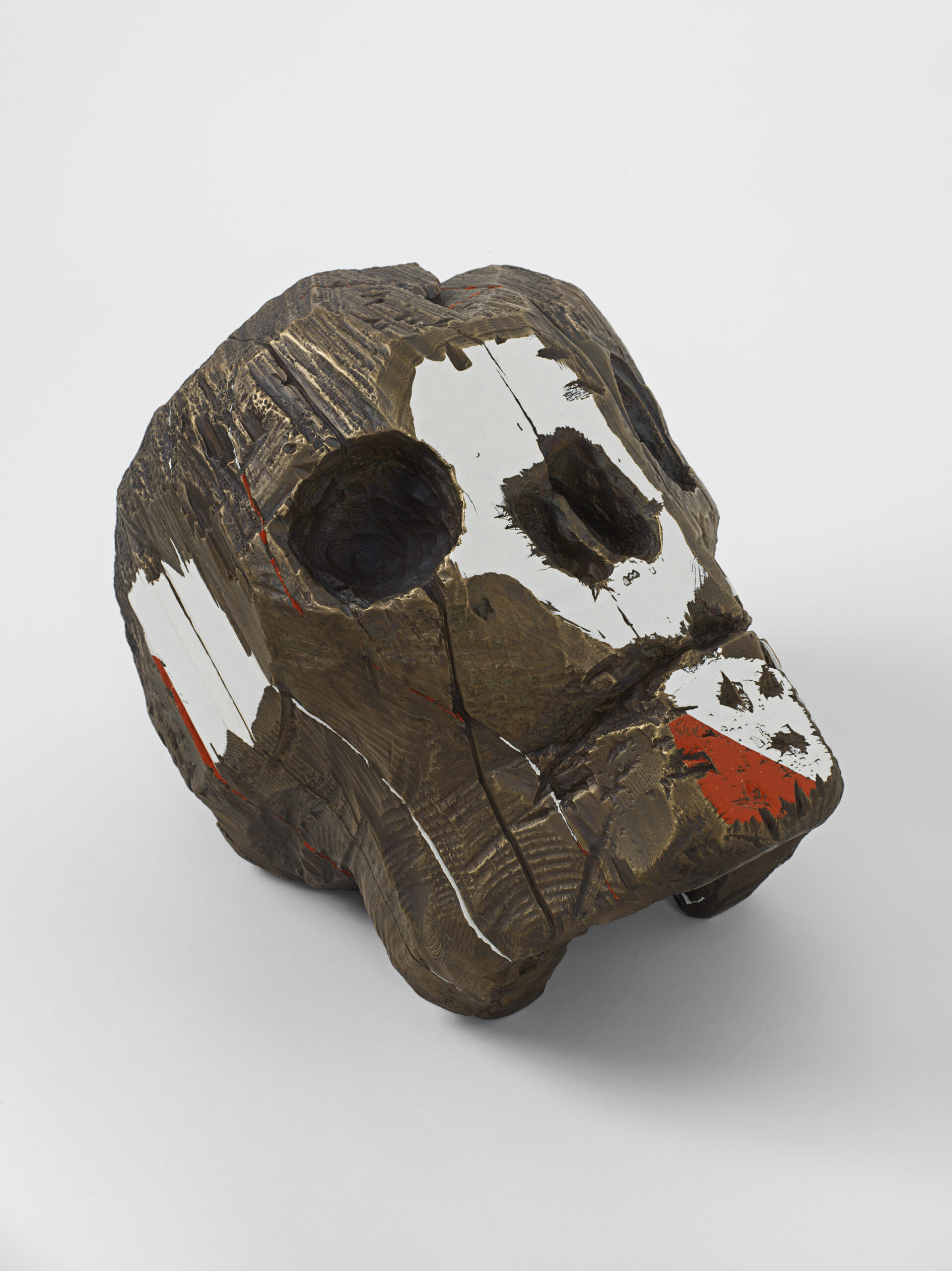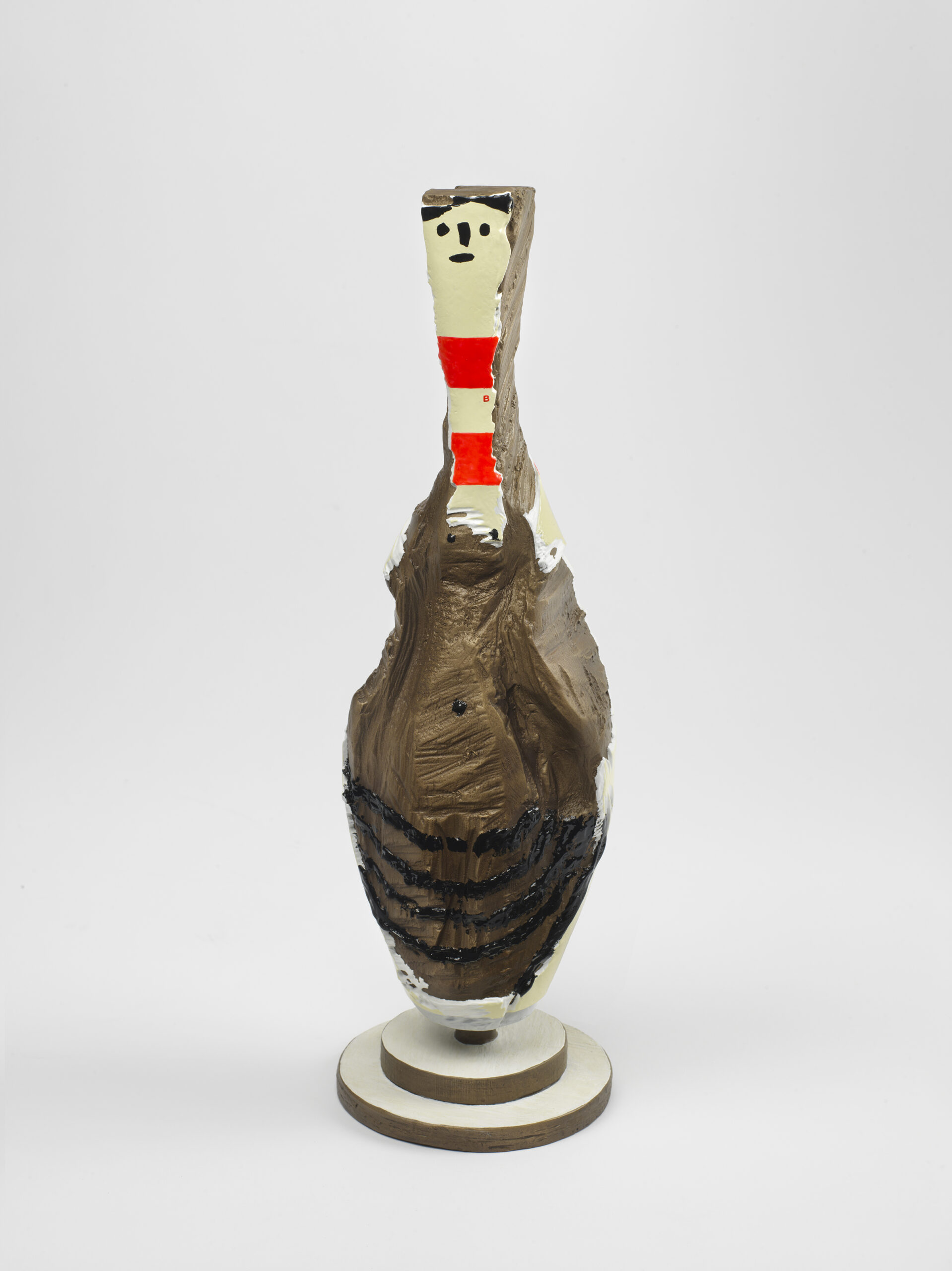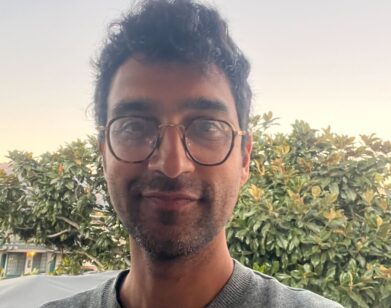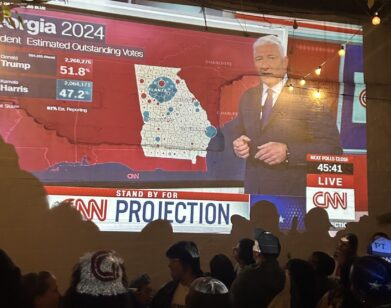provocateur
Artist Tom Sachs on Chainsaws, Cybertrucks, and Egg McMuffins

“As much as you need to know what you’re doing, you equally need to not know what you’re doing,” an animated Tom Sachs hurled at me last week, crossed-legged, with his shoes off at Acquavella, where his exhibition Bronze opened earlier this month. “An artist’s best work lies just beyond their ability to understand it.” This was just one of the many lofty maxims that seem to guide Sachs’ practice and psychology. The polarizing artist speaks with the urgency of a method actor, the conviction of a tech entrepreneur, and the warmth of a creative who truly wants to be understood. Bronze is a continuation of the bricolage sculptures for which he’s well known, but this time he’s channeled the spirit of Pablo Picasso, who he thinks is best studied as a system–another one of his intellectual fixations.
The artist, who’s become something of a household name for his longstanding collaborations with Nike and NASA, found himself in hot water last year after an article published in 2023 accused him of running his studio under abusive, cult-like conditions. Since he’s made few public statements about the allegations, I was curious to know how he’d navigated the turmoil, and if it prompted any self-reflection. But when I broached the topic, he asked that we go off the record. We did, however, get a chance to discuss a number of things that helped me come to a greater understanding of both Tom Sachs the artist and Tom Sachs the man, including Elon Musk, hypebeasts, chainsaws, McDonald’s, and art in the age of Trump.
———
SACHS: Sorry for the Instagram follow. I just wanted to see who I was talking to. I also read your Brian Oakes interview, because Brian worked on my team.
SANDSTROM: Oh, really?
SACHS: Yeah, he’s great. I had not been keeping up, but I was so impressed with how far he’s come. And we both share our admiration for Jon Kessler, who’s a close friend.
SANDSTROM: I love that. I figured you might have something to say about systems and—
SACHS: Well, there are many things that are interesting in the world, and art is one of them. I was recently interested in things like PERT, and then CPM. These are all these industrial organization protocols, and a lot of them are developed for use by the defense industry, but Fortune 500 companies use them too. They’re kind of like religions of organization, with jargon and devotees and rigidity. The inflexibility from an art point of view, for me, always becomes where it meets humor, because entropy is inevitable. There’s this one in Japan where, if there’s a problem on the production line, they shut down the entire thing and everyone gathers around and fixes the problem as a way of shaming the person.
SANDSTROM: Oh, no.
SACHS: At first you’re like, “Wow, that’s why the Japanese are so great.” But also, it’s cruel. And I think compassion is so important. And there’s not a lot of room for compassion, and more importantly, contradiction or humor, in public perception.
SANDSTROM: We’re getting ahead of what I wanted to dig into.
SACHS: Sorry, let’s go back.
SANDSTROM: Well, the first thing I wanted to talk about was trying to understand Picasso as a system. It sounds really difficult to understand someone as a system.
SACHS: I don’t see Picasso as a system. The way you could look at Picasso as a system is as an economic instrument, and as a symbol of power and wealth and commerce, because they’re so expensive. That’s not interesting to me. What’s interesting to me is all the real art stuff about Picasso. This specific body of work that I’m working from is generally during the war. 1937 to ’45, in my view, is the most important time in Picasso’s career. No self-respecting museum would agree with that because they all believe in ’32 when he was with Marie-Thérèse [Walter]. But for me, it was this transition from—and I’m sorry, this might sound really misogynist—but women were so important to Picasso’s psychosexual makeup that in a way they define his periods. So when he was transitioning from Marie-Thérèse to Dora Maar… Sorry, I got distracted.
SANDSTROM: Me too. And now I’m thinking about that Brooklyn Museum show.
SACHS: The reason I bring up Marie-Thérèse is that she was around in ’32 and those are the most expensive Picassos. And then during the war, he’s a little looser. And when he had his next wife, Francois Gilot—and there is this pretty terrible movie with Anthony Hopkins called My Life With Picasso. Did you see it?
SANDSTROM: No.

Death’s Head, 2023. Enamel, glass beads, and ferric nitrate patina on silicon bronze. Edition 4/5 plus 3 AP 9 3/4 × 9 × 12 5/8 inches.
SACHS: It’s terrible. But there are some great moments. Anthony Hopkins is almost always fun to watch, and he is pretty good as Picasso. But after the war, when he settles down with Francois Gilot and has children with her, he’s not as angry and fucked up, so the paintings are a little gentler. They’re a little less interesting, a little less tortured. That time period captures my attention because if I made paintings like Picasso, they’d be like that. And these sculptures are an expression of that. Two of them were carved with a chainsaw by me.
SANDSTROM: Why a chainsaw, as opposed to another instrument?
SACHS: It’s just faster. If you were to carve a skull and you want it to be really meticulous, you might start with a chainsaw. Then you would sand away the marks and use finer tools. That’s what [Constantin] Brâncuși did, he would start with axes. The only reason he didn’t use a chainsaw is because it didn’t exist in his time. Picasso would’ve used things like house paint and coffee and paper, garbage or whatever. He didn’t care. And materials are agnostic as well.
SANDSTROM: You’re saying materials are agnostic?
SACHS: I am, yeah. But when you make something with chainsaws you get to brag about it because it’s macho.
SANDSTROM: Sure.
SACHS: But also you get to show how rough it is. Even at the top of Death’s Head, there’s a cut where it wasn’t right, and you can see the slice. It’s a chainsaw mark. Could I go back in and fill that with the wood and polish it and make it go away because it’s bronze? Sure. But I thought it was a vestige of the process, and that has more value and makes it more of an expression of me as an individual. The iPhone can’t have any flaws or else no one will buy it. My things have more character. The iPhone has got to be for everyone. My art’s not for everyone.
SANDSTROM: It sounds like there was some catharsis involved in the making of this show?
SACHS: How so?
SANDSTROM: The chainsaw.
SACHS: Chainsaws are fun, but they’re delicate instruments, and they’re very dangerous. If you want to use a chainsaw and live to make work, you have to plan every gesture and go really slowly and make sure the blade’s perfect. It can be tricky and there have been famous accidents. The fantastic Texas Chainsaw Massacre, and even in Pulp Fiction when he comes out with a chainsaw. I highly recommend, if you’re interested, you do it with someone who knows how.
SANDSTROM: I guess I need to try one. So this show focuses a lot on Duchamp’s readymades. And I was thinking about your brand as an artist being synonymous with merch and of course sneakers. To me, that feels kind of like the logical endpoint of the readymades.
SACHS: That’s an interesting idea. I hadn’t put that together, Duchamp and merch. But I think more about Joseph Beuys and his idea of making art accessible to everyone. I don’t care if it’s a movie or a book or an article or a sculpture or a painting or a pair of sneakers—it’s all art to me. But there are different economic touch points and accessibilities for all those things. I make things that are accessible to people, and I’m really proud that you can walk on my art. The power and connection of your body to the earth, and that I’m the conduit [for that]? That’s a huge triumph.
SANDSTROM: For sure. So the collaboration with Nike is back on, you can confirm that, and there’s a new shoe coming next year. What is your relationship like with hypebeasts and the sneakerhead community?
SACHS: I think it’s wonderful that people are excited about things and devoted to things—not just my things. It’s very hard to make sneakers. It’s very slow. And I think a lot of artists who would do great things don’t have the patience for it. I barely have the patience.
SANDSTROM: What part of the process requires patience? Going over designs multiple times?
SACHS: I mean, my studio is super efficient. I can just stay up all night if I want to make something. But when you’re working with molds and factories and bureaucracies, because there are a lot of people, it takes time. The nature of the processes is just extremely slow and bureaucratic. I mean, I really admire Nike, Apple, and Google and the people that are making big efforts to make things better. I wish that was promoted more in schools, and you had people making things instead of litigating them. I’m always encouraging young people to spend time learning how to build stuff. Even today, we’re talking and I’m like, “You should definitely explore chainsaw safely.”
SANDSTROM: Obviously it goes without saying that a huge recurring theme throughout your career is space. I wanted to talk about space politics and Elon Musk, because it’s just so topical.
SACHS: Sure.
SANDSTROM: He’s supposed to lead the Department of Government Efficiency.

Standing Woman, 2024. Enamel and patina on bronze. Edition 1/3 plus 2 AP. 14 × 5 × 2 inches.
SACHS: Yeah, they’re making a position for him. I just finished his biography.
SANDSTROM: Really?
SACHS: Which is really wonderful—up until he acquires Twitter. In the beginning, you really want him to win. He’s this kind of Asperger’s fucked up kid from South Africa who had a super violent upbringing, really talented, did some incredibly innovative things. I mean, his whole thing is different. He’s like, “We have to be the first multi-planetary species.” I’m not against that, but we have a long way to go. And the thing is, you don’t go to Mars because you fucked up planet Earth and are looking for a new home. You go so you can better understand your resources here on Earth. And there’s nothing like the work that NASA’s done to understand. I mean, I can’t speak for the man, and his public voice is so deplorable, but the possibilities of what Tesla’s doing to make electric cars work is vast.
SANDSTROM: Do you think Cybertrucks are ugly?
SACHS: I love them.
SANDSTROM: Really?
SACHS: It’s the only car I’ve seen in my entire life that’s unlike any other car. All the other cars are exactly the same.
SANDSTROM: Are you going to get one?
SACHS: It’s too showy and embarrassing, but if I had a ranch or something and no one was looking at me, I would. Because they’re beautiful. I think the context is terrible because it’s saying something about you. I couldn’t attach to that. But I’m not so interested in all those political things as much as I am the possibility of continuing the space program. And they’re doing that.
SANDSTROM: Okay. So you’re not going to delete your Twitter account in protest?
SACHS: No. Twitter is a utility. I don’t really use it. I’m more of an Instagram person, but for my Rocket Factory, for crypto stuff, it’s where people go. I also think it’s stupid to delete something in protest.
SANDSTROM: What’s your relationship with crypto now?
SACHS: It’s got a bad name because there were all these stupid Ponzi schemes, and there was a lot of garbage. But I mean, country music’s got Patsy Cline, Hank Williams, and Johnny Cash. Even the worst genres have the best artists.
SANDSTROM: That’s a good point. What did you listen to this morning?
SACHS: Before I look at my phone or listen to anything, I do output before input. I write in my journal, or do a drawing, or touch clay. Or run. I try not to let things in for at least a few minutes. Every night we have a truly psychedelic experience followed by immediate amnesia, and then our day comes in. But there’s a liminal phase. It’s even just a couple of seconds or a few minutes, if you really cultivate it you can access your subconscious mind. I think it’s important to tap into that, because it’s got answers to all the things you’re too afraid to face with your day. Even if it’s just making an “X” on a piece of paper that says to yourself, “I am better than email.” And you are. You are better than anything coming in because your inner thoughts are more important than anyone else’s.
SANDSTROM: That’s your next t-shirt: “You are better than your emails.”
SACHS: But it’s a game changer. I’m not great at it, I just have a shitty little notebook, but I just—
SANDSTROM: I’m doing morning pages too.
SACHS: Before your emails?
SANDSTROM: Before my phone. But it’s really difficult. I want to look at my phone.
SACHS: And you will.
SANDSTROM: And I do. What did you dream about last night?
SACHS: I don’t remember. But every night I go to sleep dreaming of what I’m going to do tomorrow. But very specifically what I get to do with sculpture, what parts I get to make. My biggest thrill is the sensuality of cutting something or drawing, or forming something clay. Just touching materials, conveying my ideas and dreams on paper. I’m not so good at knowing when to quit, and you kind of have to figure out how to fuck off too. But as much as you need to know what you’re doing, you equally need to not know what you’re doing. Because an artist’s best work lies just beyond their ability to understand it.
SANDSTROM: So how do you “fuck off”? What does unwinding look like for you?
SACHS: I was reading to my son and I fell asleep at eight o’clock. So I woke up at 3:30 in the morning after a full night’s sleep. And I was like, “What the hell am I going to do?” I couldn’t quite go to the studio, so I started watching Casino at four AM. I’ve seen it so many times, but I just really dig into the costumes and the tragedy of Sam Rothstein, because he was a super systems guy and his Achilles’ heel was Ginger McKenna, who’s the greatest femme fatale of all time.
SANDSTROM: On this note, I went back and watched 10 Bullets in anticipation of this conversation. And the top comment said, “It’s like listening to an even more corporate version of Fight Club.” What do you make of that?
SACHS: First of all, I love Fight Club. Fight Club is the best. There’s a rule among YouTube filmmakers—well, the second rule of YouTube filmmaking is, “Thou shalt not read thy comments.” And we all do. But it’s a rule and you shouldn’t because they’re mostly fucking trolls, which is just sad. I mean, the studio is not corporate. I wish that we were that organized. But because of comments like that, I made this other movie called Paradox Bullets, where the opposite is equally valid. Because we’re human beings and there’s contradictions, and that’s what makes it rich and valuable. Art with a political agenda is either propaganda or advertising. Art’s only successful if it’s confusing, first to the maker and then to the viewer, and when it answers some questions and opens up new ones. That’s what I’m going for, and that’s what I see as success in my work.
SANDSTROM: The day after the election, there were a bunch of tweets saying, “Well, now we have four more years of really shitty art to come.” What do you make of that?

Installation view of Bronze. Courtesy of Acquavella Galleries and the artist.
SACHS: What does that mean? That people are going to make art about how much they hate Donald Trump? That’s not art, with the exception of Marilyn Minter’s piece. That’s the only one that I approve of. It’s the one where she makes a bronze plaque with Donald Trump’s head and it’s this quote that ends with, “Grab her by the pussy.” She made a beautiful thing and installed it like public art, but it’s the most despicable, fucked up thing. But all these things about how much they hate the guy are dumb. It’s not focusing on what we can do. The Toni Morrison quote that was going around last week was so great, which is like, “Artists have to get back to work.” It’s what we do best. It might not be the outcome that we wanted, but it doesn’t change what you do every day.
SANDSTROM: Speaking of Instagram, I saw this picture of you talking about McDonald’s as a system where you’re quoting Warhol, and I want to know what your McDonald’s order is.
SACHS: My McDonald’s order is an egg McMuffin, hash browns, black coffee.
SANDSTROM: Okay. Hot coffee?
SACHS: That’s the least disgusting option.
SANDSTROM: I respect that.
SACHS: I sometimes bring my son to McDonald’s just to anger my wife, but I just let him have scrambled eggs or pancakes. It’s like eating at a diner. I mean, it’s super industrial and gross, but you won’t die.
SANDSTROM: Okay. Let me get back to my questions.
SACHS: I’m always happy to talk more about McDonald’s, because it’s the ultimate system. There’s no system more ultimate.
SANDSTROM: No, that’s okay. Well, I do want to talk about health and wellness, but I do want to talk about the Curbed article, because you haven’t done an interview where you’ve talked about it.
SACHS: Wait, hold on a second. Can we talk off the record?
SANDSTROM: Okay.
SACHS: Do you have any more questions?
SANDSTROM: I mean, only the question that you’ll walk on.
SACHS: I think we can do that via email.






